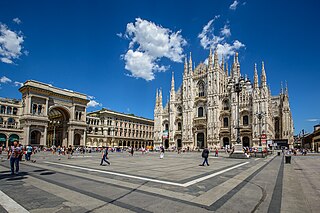
Piazza del Duomo is the main piazza of Milan, Italy. It is named after, and dominated by, Milan Cathedral. The piazza marks the center of the city, both in a geographic sense and because of its importance from an artistic, cultural, and social point of view. Rectangular in shape, with an overall area of 17,000 m2, the piazza includes some of the most important buildings of Milan, as well some of the most prestigious commercial activities, and it is by far the foremost tourist attraction of the city.

Novara is the capital city of the province of Novara in the Piedmont region in northwest Italy, to the west of Milan. With 101,916 inhabitants, it is the second most populous city in Piedmont after Turin. It is an important crossroads for commercial traffic along the routes from Milan to Turin and from Genoa to Switzerland. Novara lies between the rivers Agogna and Terdoppio in northeastern Piedmont, 50 kilometres (31 mi) from Milan and 95 kilometres (59 mi) from Turin.
Palazzo del Podestà is Italian for "Palace of the Chief Magistrate" of a town.
In Middle Age Communes in Italy, a broletto was the place where the whole population met for democratic assemblies, and where the elected men lived and administered justice.

The Loggia degli Osii is a historical building of Milan, Italy. It is located in Piazza Mercanti, a central city square of Milan that used to be its centre in the Middle Ages.

Villas and palaces in Milan are used to indicate public and private buildings in Milan of particular artistic and architectural value. Milan has always been an important centre with regard to the construction of historical villas and palaces, ranging from the Romanesque to the neo-Gothic, from Baroque to Rococo.

The Royal Palace of Milan was the seat of government in the Italian city of Milan for many centuries. Today, it serves as a cultural centre and it is home to international art exhibitions. It spans through an area of 7,000 square meters and it regularly hosts modern and contemporary art works and famous collections in cooperation with notable museums and cultural institutions from across the world. More than 1,500 masterpieces are on display annually.

Oldrado da Tresseno was an Italian politician, podestà (mayor) of Milan in the 13th century. He is responsible for restructuring Piazza dei Mercanti and ordering the construction of Palazzo della Ragione, a prominent historic building of Milan, which served as a broletto in the Middle Ages. He is also remembered as a fierce prosecutor of the Cathar heretics.

Palazzo Marino is a 16th-century palace located in Piazza della Scala, in the centre of Milan, Italy. It has been Milan's city hall since 9 September 1861. It borders on Piazza San Fedele, Piazza della Scala, Via Case Rotte and Via Tommaso Marino.

Piazza Mercanti is a central city square of Milan, Italy. It is located between Piazza del Duomo, which marks the centre of the modern city of Milan, and Piazza Cordusio, and it used to be the heart of the city in the Middle Ages. At the time, the square was larger than it is now and known as "Piazza del Broletto", after the "Broletto Nuovo", the palace that occupied the centre of the square. In the 13th century, there were six entry points to the square, each associated to a specific trade, from sword blacksmiths to hat makers.

Casa Panigarola, also known as Palazzo dei Notai, is a historic building of Milan, Italy, located in Piazza Mercanti, former city centre in the Middle Ages. It is named after the House of Panigarola, a family of notaries from Gallarate, that owned the building until 1741. The building thus served as a notary seat, and the activities therein were strictly related to those that occurred in the adjacent Palazzo della Ragione, where trials were held.

The Palazzo delle Scuole Palatine is a historic building of Milan, Italy, located in Piazza Mercanti, the former city centre in the Middle Ages. It served as the seat of the most prestigious higher school of medieval Milan. Many notable Milanese scholars of different ages studied or taught in these schools; Augustine of Hippo and Cesare Beccaria, among others, served as teachers in the Palatine. The current building dates back to 1644, when it replaced an older one, which had the same function and was destroyed by a fire.

The Giureconsulti Palace, also known as Palazzo Affari ai Giureconsulti or simply Palazzo Affari, is a 16th-century building of Milan, Italy. It is located in Piazza Mercanti, former city centre in the Middle Ages.

The Zone 1 of Milan, since 2016 officially Municipality 1 of Milan, is one of the 9 administrative divisions of Milan, Italy.
Francesco Croce (1696–1773) was an Italian baroque architect. He was mainly active in Milan, where he worked for the Veneranda Fabbrica del Duomo di Milano. Among other things, he designed the highest spire of the Duomo, the guglia del tiburio, on top of which the Madonnina statue is currently placed.

Piazza delle Erbe is one of the many squares in the historic center of Padua. For centuries, with Piazza della Frutta, it was the commercial center of the city. In the two squares is one of the largest markets in Italy. Unlike Piazza dei Signori, the civic theater of celebrations, Piazza delle Erbe was the site of the folk festivities. The square is dominated by the imposing Palazzo della Ragione.

The following outline is provided as an overview of and topical guide to Milan:

The Broletto or Broletto Palace of Pavia, Italy has for centuries housed the civic government offices of this city found in the region of Lombardy, Italy. The term Broletto refers to a buildings equivalent to the town hall or town assembly.















